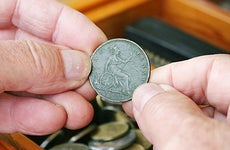Sell your junk for cash
The Bankrate promise
At Bankrate we strive to help you make smarter financial decisions. While we adhere to strict , this post may contain references to products from our partners. Here's an explanation for .
Sell your junk for cash
Admit it: You have too much stuff, whether clothes spill out of closets, toys fill your basement or you can’t actually park your car in the garage. You’re not alone. Americans spend $20 billion per year on storage units, according to the National Storage Association.
If you’re sick of the mess, or want to stop spending money to store stuff you don’t use, sell your junk.
“There is no use holding onto things that could instead put money in your pocket. The longer you hold on to things, the more their value depreciates and the longer you are left maintaining it,” says Cristin Frank, founder of The Eve of Reduction, a company that helps people reduce waste, debt and consumption.
Don’t just dump your stuff on the curb for the next garbage pickup. Consider these four ways to turn your clutter into cash.
Hold a yard sale

Does your town or community hold a yard sale day? Join in. You’ll get more shoppers than if you go it alone.
Ben Garvey of Audubon, N.J., participates in his town’s yard sale every year. His sells almost everything for $1. He’s made between $260 and $300 every year he’s participated.
Exceptions to the $1 rule are anything that costs less than $1 new, and more costly items like furniture, DVDs and video games, which he prices between $2 and $5. He marks books at 50 cents because he says they don’t usually sell well, and he’d rather have shoppers take two than none.
Garvey advises that you clean and dust everything before you put it out. Interacting with your shoppers helps, too. “Be friendly! Say hello, chat them up, and they’re far more likely to buy something from you.”
Sell it online

If you have something collectible or brand-specific that’s easy to ship, you can list it for sale on eBay. You’ll pay a transaction fee, but it’s an easy way to have people bid on stuff you want to get rid of.
An alternative: You can sell almost anything through Craigslist.org, which is free.
“Kids’ items and recognizable brand names sell great on Craigslist,” says Frank. “I sold a Schwinn jogging stroller, Power Wheels riding toys and a Weber gas grill in less than 24 hours.”
The keys to quick sales are good pictures and accurate descriptions.
Make Craigslist transactions in cash, and if the item is small, meet the person in a public place. If the buyer comes to your home, arrange to have someone there with you, and make sure your buyer knows the dimensions of the item.
“There’s nothing worse than having a buyer at your door and the only thing preventing him from getting it out of your house is that he didn’t bring a big enough truck,” says Jill Valeri, owner of The Welcome Home: Interior Design Solutions, who sells furniture on Craigslist.
Be realistic about pricing, too. Start at half of what you paid retail.
Consign it

If you want someone else to do the work for you, take your items to a consignment shop. They’ll sell your stuff in exchange for a cut of the profits, usually 50 percent.
Marcia Turner, a writer and author in Rochester, N.Y., has consigned womens, kids and baby clothes, as well as furniture.
“Go through your closet and identify things you haven’t worn in years, or you’re tired of but are still in good shape,” she says. Turner washes and irons everything so they look ready to put on the racks.
Stores have different policies about taking in clothes. Turner’s favorite is Lu’s Back Door in Fairport, N.Y. They’ll look at your items without an appointment, though some consignment shops won’t even talk to you unless you call ahead. Once they go through your pile and pick what they think will sell, all you have to do is wait for a check.
Furniture consignment works the same way. Make sure you call ahead to see if they’re buying, or bring pictures into the store before loading it up on the truck, says Turner.
Give it away

You can also generate cash indirectly by giving your stuff away. “What you get from donating, besides good graces, is a tax write-off,” says Frank.
Make sure you’re donating to a registered nonprofit — ask for verification if you’re not going with a big-name charity such as Goodwill — and get a receipt. When tax time rolls around, file a Form 1040 and itemize your deductions on Schedule A.
Resources

Check out these stories to learn how to maximize your income potential when you sell your junk. Or if you decide to give away your stuff, at least get the tax write-off.
- Tips for a successful yard sale
- Where to sell your junk for cash
- 4 ways to make cash online
- Gifts to charity pay off on taxes
- 4 tips for thrift store shopping
Related Articles


